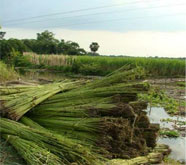
The jute fibre
Jute is a seasonal agricultural commodity product widely grown in Bangladesh, India, Nepal, Myanmar, Thailand and Vietnam. Raw jute crop is an important cash crop to the farmers. Cultivation of raw jute crop provides not only fibre, which has industrial use, but also jute stick which is an important fuel to the farming community.
It is produced mainly in the states of West Bengal, Bihar, Assam, Orissa, Andhra Pradesh, Tripura and Meghalaya.
Two species of jute commonly cultivated are white and tossa jute. It is second most important vegetable fibre after cotton, in terms of consumption and production. Jute plants are usually 2.5-3.5metre in height. Only a small portion of the plant (approx 4-6%) is utilised for extracting its fibre. The fibre is separated from the plant by tying the plants in bundles and immersing them in running or stagnant water for a sufficient period. The process is called retting. It is a photo reactive plant which needs 120 days for its harvesting.
Temperate, wet and humid climate are conducive for its growth. Being 100% natural, eco-friendly, renewable, biodegradable it causes very little environmental pollution.
Products at a glance

- Jute Hessian Cloth
- Twill Sacking Bags
- Double Warp Bags
- Soil Savers & Ground Covers
- Jute Twine & Yarn
- Jute Webbing
- Jute Bags